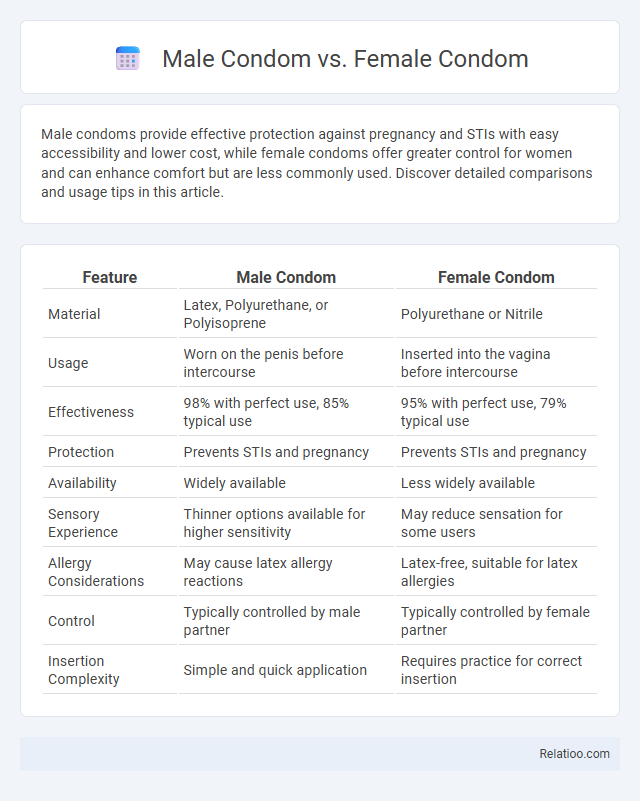Male condoms provide effective protection against pregnancy and STIs with easy accessibility and lower cost, while female condoms offer greater control for women and can enhance comfort but are less commonly used. Discover detailed comparisons and usage tips in this article.
Table of Comparison
| Feature | Male Condom | Female Condom |
|---|---|---|
| Material | Latex, Polyurethane, or Polyisoprene | Polyurethane or Nitrile |
| Usage | Worn on the penis before intercourse | Inserted into the vagina before intercourse |
| Effectiveness | 98% with perfect use, 85% typical use | 95% with perfect use, 79% typical use |
| Protection | Prevents STIs and pregnancy | Prevents STIs and pregnancy |
| Availability | Widely available | Less widely available |
| Sensory Experience | Thinner options available for higher sensitivity | May reduce sensation for some users |
| Allergy Considerations | May cause latex allergy reactions | Latex-free, suitable for latex allergies |
| Control | Typically controlled by male partner | Typically controlled by female partner |
| Insertion Complexity | Simple and quick application | Requires practice for correct insertion |
Overview of Male and Female Condoms
Male condoms are thin, flexible sheaths typically made from latex, polyurethane, or polyisoprene, designed to fit over the penis and act as a barrier to prevent pregnancy and reduce the transmission of sexually transmitted infections (STIs). Female condoms, made from nitrile or polyurethane, are inserted into the vagina prior to intercourse, offering similar protection by lining the vaginal walls and preventing direct genital contact. Your choice between male and female condoms can impact comfort, control, and protection levels during safe sex practices, making understanding their proper use essential for effective STI and pregnancy prevention.
Material and Design Differences
Male condoms are typically made from latex, polyurethane, or polyisoprene, featuring a sheath design that fits over the penis to create a barrier against sperm and sexually transmitted infections (STIs). Female condoms are usually crafted from nitrile or polyurethane, designed as a pouch with flexible rings at both ends to fit inside the vagina, providing internal protection. Both condom types promote safe sex by preventing direct contact and fluid exchange, but their material compositions and ergonomic designs cater to different user preferences and anatomical requirements.
How Each Condom is Used
Male condoms are worn over an erect penis before any genital contact, providing a barrier that prevents sperm from entering the vagina. Female condoms are inserted into the vagina prior to intercourse, lining the vaginal walls and partially covering the external genitalia for protection. You can choose either condom type based on comfort and convenience to effectively reduce the risk of sexually transmitted infections and unintended pregnancies during safe sex.
Effectiveness in Preventing Pregnancy
Male condoms have a 98% effectiveness rate with perfect use in preventing pregnancy, while female condoms offer about 95% effectiveness with ideal use. Both provide strong protection when used correctly, but typical use reduces effectiveness due to human error. Ensuring consistent and proper use of your chosen barrier method is crucial to maximize pregnancy prevention and promote safe sex.
Protection Against Sexually Transmitted Infections
Male condoms provide up to 98% protection against sexually transmitted infections (STIs) when used consistently and correctly, acting as a barrier to prevent direct contact with bodily fluids. Female condoms offer similar protection levels, covering a larger area of the genital region and potentially reducing exposure to STIs not covered by male condoms. You can enhance your safety during sexual activity by choosing the right condom type and combining it with regular STI testing and open communication with partners.
Comfort and Sensation Comparison
Male condoms provide a snug fit and often enhance sensitivity with ultra-thin materials, offering reliable protection during intercourse. Female condoms offer greater internal control and can increase comfort for partners who prefer a less constrictive option, though some may find insertion challenging initially. Safe sex practices prioritize consistent and correct use of both condom types, ensuring protection while balancing comfort and sensation to maintain a pleasurable experience.
Accessibility and Cost
Male condoms are widely accessible and inexpensive, available over-the-counter in most pharmacies and supermarkets globally. Female condoms, while providing an effective alternative for safe sex, tend to be less accessible and more costly, limiting widespread use in many regions. Cost-effectiveness and availability of male condoms contribute significantly to their dominance in safe sex practices worldwide.
Advantages of Male and Female Condoms
Male condoms provide effective protection against sexually transmitted infections (STIs) and unintended pregnancies, offering easy accessibility and cost-effectiveness. Female condoms offer enhanced control for women, are latex-free, and can be inserted hours before intercourse, increasing spontaneity and comfort. Both condom types promote safer sex by creating a barrier that reduces the risk of pathogen transmission and support inclusive sexual health practices.
Potential Drawbacks and Concerns
Male condoms may cause reduced sensation and potential latex allergies, while female condoms can be challenging to insert correctly and are less widely available, affecting accessibility. Some users report discomfort or noise during use with female condoms, which may impact overall satisfaction. Your choice should consider these drawbacks alongside safe sex practices to ensure maximum protection and comfort.
Choosing the Right Condom for You
Choosing the right condom involves understanding the distinct benefits of male and female condoms to best suit Your needs and preferences. Male condoms are widely accessible, typically made from latex or polyurethane, and offer reliable protection against STIs and pregnancy when used correctly. Female condoms provide an alternative made from nitrile, allowing greater control and comfort, especially for those sensitive to latex, enhancing safe sex practices with dual protection.

Infographic: Male Condom vs Female Condom
 relatioo.com
relatioo.com